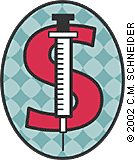
By planning ahead, you can take at least some of the red ink out of giving flu shots.
Fam Pract Manag. 2002;9(4):16

Giving flu shots has become a losing proposition over the last couple of years. Short or delayed supplies of flu vaccine have driven up costs, and reimbursement has not kept pace. Although it’s hard to think about the flu in springtime, now is the time to take steps to turn the situation around for the next flu season.
1. Shop early
Ordering your flu vaccine now may allow you to avoid price hikes that occur as the flu season approaches. Practices who wait until the last minute pay a premium, just like last-minute airline passengers.
2. Buy direct and collectively
If possible, order your flu vaccine directly from a manufacturer. According to the Centers for Disease Control National Immunization Program, the three manufacturers licensed to distribute flu vaccine in the United States are Aventis Pasteur (800–822–2463), Wyeth (800–358–7443) and Henry Schein (800–772–4346). If you can’t order from the manufacturer, then consider a distributor. If at all possible, avoid buying your vaccine supply from a retail pharmacy. There is a mark-up each step of the way between you and the manufacturer.
Along the same lines, you may be able to buy more cheaply if you join a purchasing collective or other group that’s able to buy in larger quantities. Manufacturers and distributors are more likely to give a price break to those who buy in larger quantities.
3. Give more efficiently
Mass immunizers take advantage of economies of scale and make the most efficient use of their resources. There is no reason that you cannot do the same. Schedule a flu shot clinic in your practice on a given date and promote it in advance. You may want to offer one clinic early in the season for high-risk patients and one later in the season for everyone else.
4. Bill completely
Remember to bill for the vaccine itself as well as for its administration. If the patient owes a co-payment, collect it up front.
Use these CPT codes for influenza vaccine:
90657, “Influenza virus vaccine, split virus, 6–35 months dosage, for intramuscular or jet injection use,”
90658, “Influenza virus vaccine, split virus, 3 years and above dosage, for intramuscular or jet injection use,”
90659, “Influenza virus vaccine, whole virus, for intramuscular or jet injection use,”
90660, “Influenza virus vaccine, live, for intranasal use.”
For Medicare patients, the appropriate administration code is G0008, “Administration of influenza virus vaccine.” For all other patients, the administration code for 90657, 90658 and 90659 is 90471, “Immunization administration (includes percutaneous, intradermal, subcutaneous, intramuscular and jet injections); one vaccine (single or combination vaccine/toxoid).” For 90660, the administration code is 90473, “Immunization administration by intranasal or oral route; one vaccine (single or combination vaccine/toxoid).”
Diagnosis code V04.8, “Need for prophylactic vaccination and inoculation against certain viral diseases; influenza,” should be used to support your administration and vaccine codes.
5. Use Medicare roster billing
Medicare offers a simplified claims filing procedure that allows you to bill for the influenza virus vaccine benefit for multiple beneficiaries if you agree to accept assignment for these claims. You may not collect any payment from beneficiaries. The procedure, known as roster billing, allows you to submit a single HCFA-1500 claim form with an attached roster of information for the beneficiaries vaccinated. Roster bills are not paid as quickly as electronic claims, but the cost savings of submitting a single claim form with a simple roster attached can outweigh this disadvantage. For more information on roster billing, contact your Medicare carrier, or view section 4480.6 of the Medicare Carriers Manual online atwww.hcfa.gov/pubforms/14_car/3b4480.htm#_4480_6. You may also want to contact some of the commercial insurers you commonly deal with to see if they offer a similar option.
For additional information about immunizations, including guidelines and links to supply updates, visitwww.aafp.org/immunization andwww.cdc.gov/nip. Giving the flu vaccine may never be a cash cow for your practice. However, if you implement some or all of these suggestions, you may be able to cut your losses.